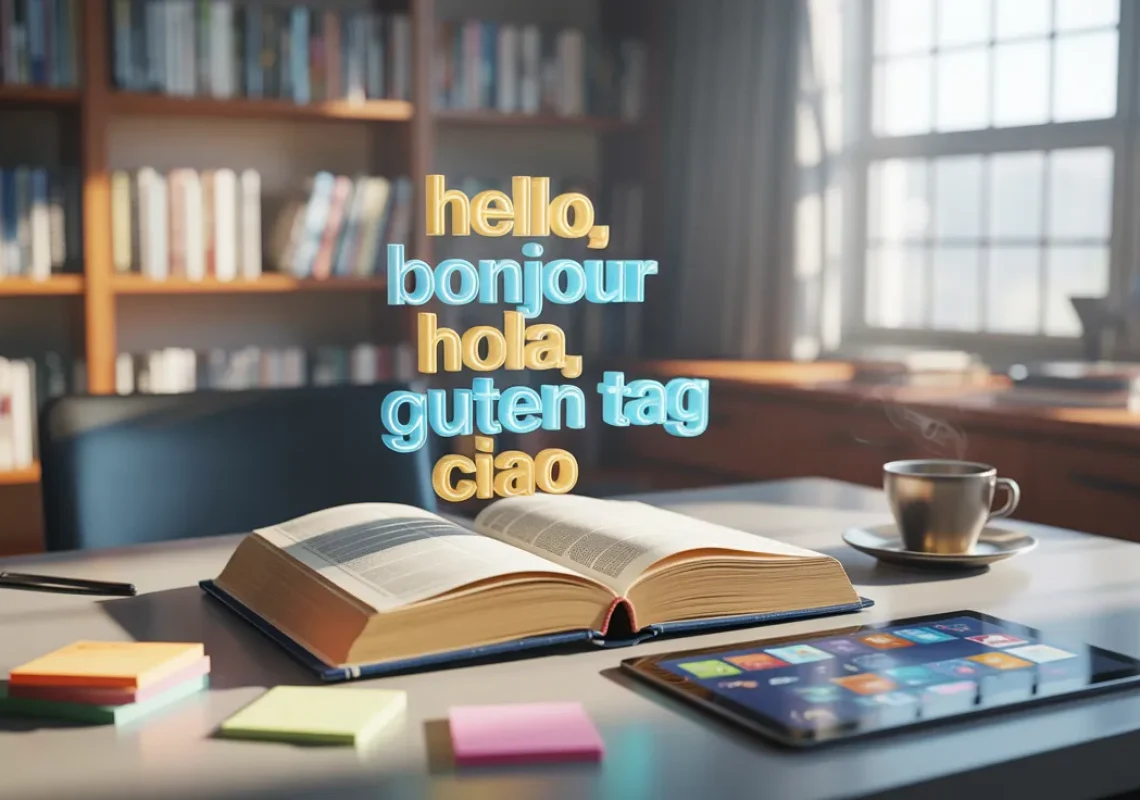Unlocking the Power of Multilingual Vocabulary
In today’s interconnected world, the ability to communicate across languages is more than just a skill – it’s a gateway to endless opportunities. Imagine navigating the bustling streets of Paris, engaging in a lively debate in Tokyo, or savoring the rich flavors of a traditional dish in Mexico City, all while effortlessly switching between languages. This isn’t just a dream; it’s a reality within your reach. Expanding your vocabulary across different languages opens doors to new cultures, enhances cognitive abilities, and fosters deeper connections with people from diverse backgrounds. But how do you embark on this transformative journey?
The key lies in immersive learning. Traditional methods often focus on rote memorization, but to truly internalize a language, you must experience it in context. Engage with native speakers, consume media in the target language, and immerse yourself in environments where the language is spoken. This approach not only enriches your vocabulary but also helps you understand the nuances and cultural contexts behind words.
Additionally, leveraging technology can accelerate your learning process. Language learning apps, online courses, and virtual exchange programs provide interactive platforms to practice and expand your vocabulary. These tools offer personalized learning experiences, allowing you to focus on areas where you need improvement and track your progress over time.
Remember, consistency is crucial. Dedicate time each day to learning new words and phrases, and actively use them in conversations. The more you practice, the more confident you’ll become in your multilingual abilities. So, take the plunge and start expanding your vocabulary today – your future self will thank you.
Embracing the Beauty of Linguistic Diversity
Every language is a reflection of its culture, history, and worldview. By learning new languages, you gain access to a treasure trove of expressions, idioms, and concepts that may not have direct translations in your native tongue. This linguistic diversity enriches your understanding of the world and enhances your ability to think critically and creatively.
For instance, the German word “Fernweh” describes a longing for distant places – a sentiment that many travelers can relate to but may not have a single word for in English. Similarly, the Japanese concept of “Wabi-sabi” appreciates the beauty in imperfection and transience, offering a unique perspective on aesthetics and life.
Exploring these linguistic nuances not only broadens your vocabulary but also deepens your appreciation for different cultures. It fosters empathy and open-mindedness, qualities that are essential in our globalized society. So, embrace the beauty of linguistic diversity and let it inspire you to learn and grow.
Strategies for Effective Vocabulary Acquisition
Expanding your vocabulary across languages requires more than just memorizing words – it involves adopting effective strategies that facilitate long-term retention and practical usage. One such strategy is the use of spaced repetition systems (SRS), which involve reviewing words at increasing intervals to reinforce memory.
Another effective technique is the creation of personalized vocabulary lists. As you encounter new words, write them down along with their meanings and example sentences. Review these lists regularly and try to incorporate the words into your daily conversations. This active usage helps solidify your understanding and recall of the words.
Additionally, context plays a vital role in vocabulary acquisition. Instead of learning words in isolation, study them within sentences or real-life scenarios. This approach helps you understand how words function in different contexts and enhances your ability to use them appropriately.
Finally, don’t be afraid to make mistakes. Language learning is a journey, and errors are an inevitable part of the process. Embrace them as learning opportunities and continue practicing with confidence. With dedication and the right strategies, you’ll find your vocabulary expanding across languages in no time.
Leveraging Technology for Language Learning
In the digital age, technology offers a plethora of tools to aid in language learning. From mobile apps to online courses, these resources provide interactive and engaging ways to expand your vocabulary across different languages.
Language learning apps like Duolingo, Babbel, and Memrise offer gamified lessons that make learning fun and accessible. These platforms cover a wide range of languages and skill levels, allowing you to learn at your own pace and convenience.
Online courses and platforms such as Coursera, edX, and iTalki connect you with experienced instructors and fellow learners from around the world. These platforms offer structured lessons, live sessions, and cultural exchange opportunities that enhance your learning experience.
Moreover, social media platforms like YouTube and Instagram provide a wealth of content in various languages. Following native speakers, language influencers, and educational channels exposes you to authentic language usage and cultural insights.
By integrating these technological tools into your learning routine, you can create a dynamic and immersive environment that accelerates your vocabulary acquisition across languages.
Immersing Yourself in Real-Life Language Experiences
While digital tools are valuable, nothing compares to the experience of immersing yourself in a language-rich environment. Traveling to countries where the target language is spoken allows you to practice vocabulary in real-life situations, from ordering food at a local restaurant to engaging in conversations with native speakers.
Participating in language exchange programs or cultural events also provides opportunities to practice vocabulary in authentic contexts. These experiences not only enhance your language skills but also foster meaningful connections with people from different cultures.
If traveling isn’t feasible, consider joining local language clubs or online communities where you can interact with fellow learners and native speakers. These platforms offer a supportive environment to practice and expand your vocabulary through discussions, games, and collaborative activities.
Remember, the key to effective language learning is consistent practice and exposure. By immersing yourself in real-life language experiences, you can accelerate your vocabulary acquisition and gain a deeper understanding of the language and culture.
Overcoming Challenges in Multilingual Vocabulary Expansion
Expanding your vocabulary across multiple languages is an exciting endeavor, but it comes with its own set of challenges. One common obstacle is interference between languages, where similarities between words in different languages can lead to confusion.
To overcome this, it’s essential to focus on the unique aspects of each language. Pay attention to pronunciation, grammar, and usage patterns that distinguish one language from another. This approach helps prevent mixing up words and reinforces your understanding of each language.
Another challenge is maintaining motivation over time. Language learning is a long-term commitment, and it’s easy to become discouraged if progress seems slow. To stay motivated, set realistic goals, celebrate small victories, and remind yourself of the reasons you started learning in the first place.
Additionally, seek support from fellow learners or language mentors. Sharing experiences, challenges, and successes with others can provide encouragement and accountability, making the learning process more enjoyable and effective.
By acknowledging these challenges and proactively addressing them, you can navigate the complexities of multilingual vocabulary expansion and continue making progress toward your language learning goals.
Real-World Success Stories: The Impact of Multilingual Vocabulary
Numerous individuals have experienced transformative changes in their personal and professional lives by expanding their vocabulary across different languages. Take, for example, Maria, a marketing professional who learned Mandarin to connect with clients in China. Her ability to speak the language fluently not only strengthened business relationships but also opened doors to new career opportunities.
Similarly, Ahmed, a software developer from Pakistan, learned Spanish to collaborate with tech teams in Spain. His multilingual skills enhanced communication, streamlined project workflows, and led to successful international partnerships.
These success stories highlight the tangible benefits of multilingual vocabulary expansion. Whether it’s advancing in your career, building international networks, or gaining a deeper appreciation for diverse cultures, the ability to communicate across languages is a powerful asset.
So, take inspiration from these real-world examples and embark on your own journey of vocabulary expansion. With dedication, the right strategies, and a passion for learning, you can achieve fluency in multiple languages and unlock a world of possibilities.
Conclusion: Your Path to Multilingual Mastery
Expanding your vocabulary across different languages is a rewarding endeavor that enriches your life in countless ways. By embracing immersive learning, leveraging technology, and immersing yourself in real-life language experiences, you can accelerate your language acquisition and gain a deeper understanding of the world.
Remember, consistency and practice are key. Dedicate time each day to learning new words, engage with native speakers, and seek out opportunities to use your new vocabulary in real-life situations. The more you practice, the more confident and proficient you’ll become.
So, why wait? Start your journey toward multilingual mastery today. The world is waiting for you to explore, connect, and communicate in new and exciting ways.





